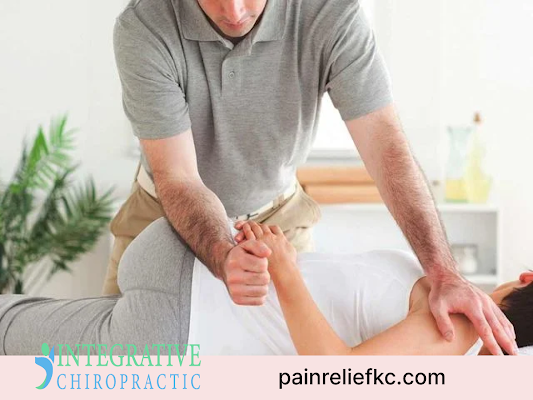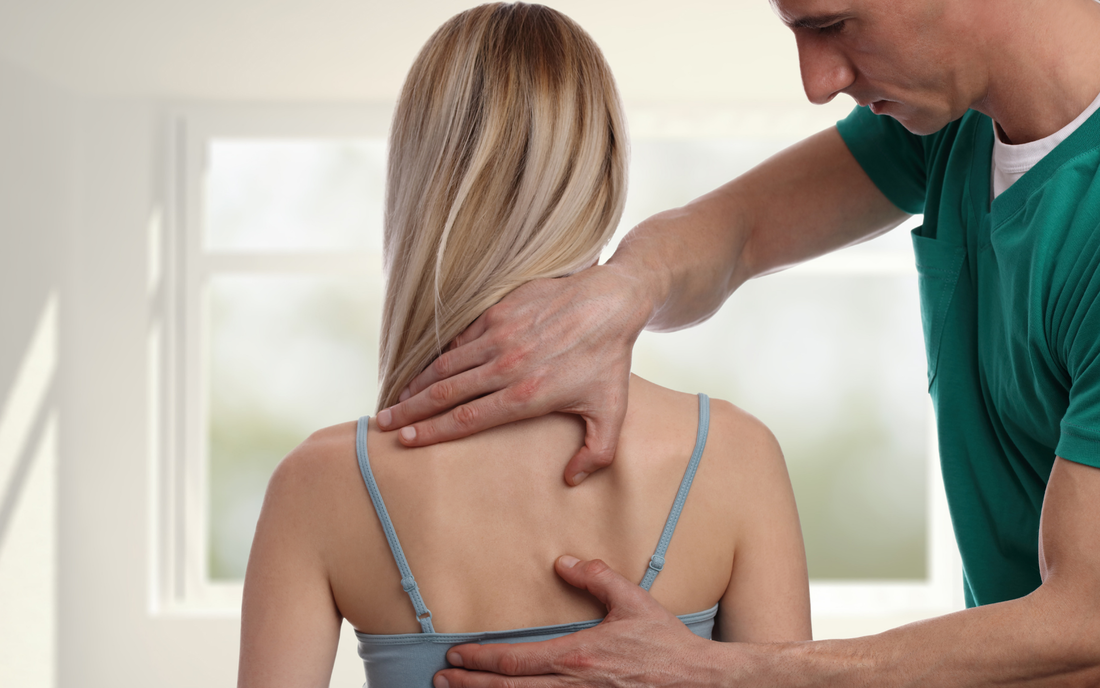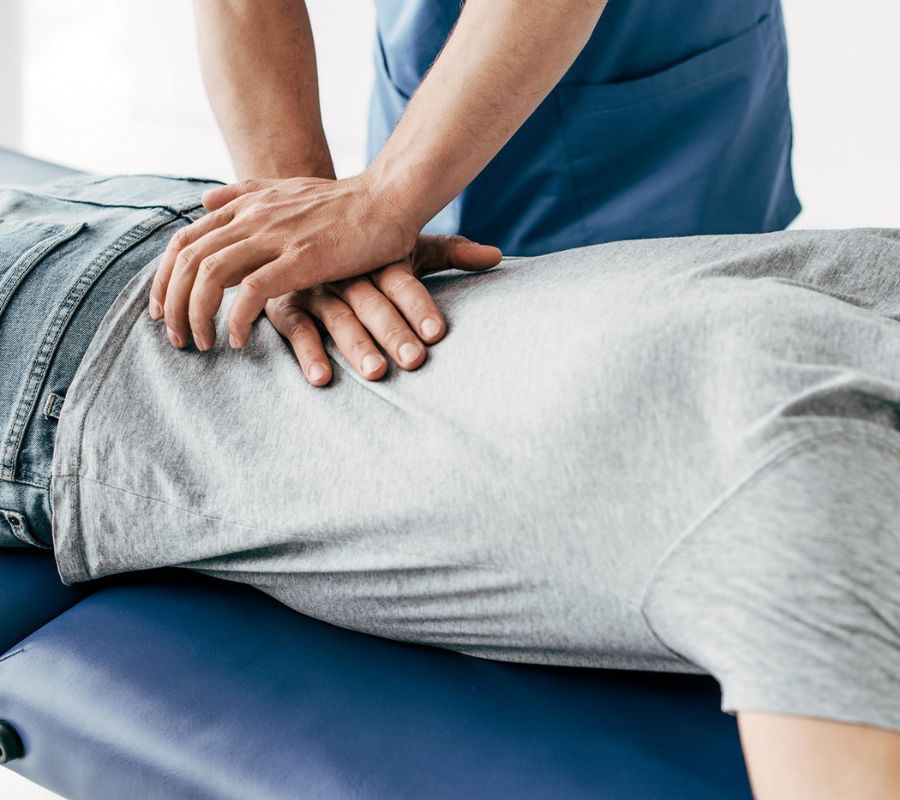Positional Release Therapy
Overland Park
Unlocking Pain-Free Movement with
Positional Release Therapy: A Chiropractor’s Guide
Positional Release Therapy (PRT) is a manual therapy technique that has been gaining popularity among chiropractors for its ability to alleviate pain and restore movement in patients. PRT is based on the principle that certain positions can trigger the release of muscle tension, leading to pain relief and improved mobility. This therapy is non-invasive and gentle, making it a popular choice among patients who are seeking a drug-free alternative to manage their pain. In this post, we will delve into the basics of PRT, its benefits, and how it can help improve the quality of life for individuals suffering from chronic pain and other musculoskeletal conditions.

What is Positional Release Therapy?
Positional Release Therapy (PRT) is a manual therapy technique that is used to relieve pain and improve movement. It is based on the concept that specific positions can trigger the release of muscle tension, leading to pain reduction and increased mobility. The therapy involves applying gentle pressure to trigger points or “tender spots” in the muscle, with the goal of relaxing the muscle and reducing pain.
PRT is a non-invasive, gentle form of therapy that is well-suited for individuals who are seeking a drug-free alternative to manage their pain. It is commonly used to treat a variety of musculoskeletal conditions, such as back pain, neck pain, shoulder pain, and headaches, among others. The therapy is performed by a trained chiropractor who uses their hands to apply gentle pressure to specific points on the body. The therapy is usually performed in a series of short sessions, with the number and frequency of sessions depending on the individual’s specific needs and the severity of their condition.
Overall, PRT is a safe and effective way to manage pain and improve mobility, making it an increasingly popular choice among patients and healthcare providers alike.
How does it work?

Positional Release Therapy (PRT) works by taking advantage of the body’s natural reflexes to relieve pain and improve movement. The therapy is based on the idea that certain positions can stimulate the release of muscle tension, leading to pain reduction and increased mobility.
During a PRT session, the chiropractor will apply gentle pressure to trigger points or tender spots in the muscle. This pressure stimulates the body’s reflexes, causing the muscle to relax and reducing tension. By reducing muscle tension, PRT helps to relieve pain and improve mobility.
The chiropractor will typically use their hands to apply pressure, although other tools, such as balls or rollers, may also be used. The pressure is usually applied for a short period of time, usually between 30 seconds to 2 minutes, depending on the individual’s specific needs and the severity of their condition.
The therapy is highly individualized and tailored to each patient’s specific needs. The chiropractor will carefully assess the patient’s condition and determine the best approach to relieve pain and improve movement. This may involve using a variety of techniques, such as stretches, massages, or other manual therapies.
PRT is a safe and effective way to manage pain and improve mobility, with very few side effects. It is a non-invasive, drug-free alternative to managing pain and can be used in conjunction with other treatments, such as physical therapy or chiropractic adjustments. Overall, PRT is an effective and holistic approach to pain management, with a focus on restoring natural movement patterns and improving quality of life.
The procedure
The procedure for Positional Release Therapy (PRT) typically involves the following steps:
- Assessment: The chiropractor will perform a thorough evaluation of the patient’s condition, including a medical history, physical examination, and range of motion tests. This information will help the chiropractor determine the best approach to relieve pain and improve mobility.
- Identification of Trigger Points: The chiropractor will use their hands to identify trigger points or tender spots in the muscle that may be causing pain or contributing to movement restrictions.
- Application of Pressure: The chiropractor will apply gentle pressure to the trigger points, using their hands or other tools such as balls or rollers. The pressure is usually applied for a short period of time, usually between 30 seconds to 2 minutes.
- Muscle Relaxation: The pressure applied to the trigger points will stimulate the body’s reflexes, causing the muscle to relax and reducing tension. This helps to relieve pain and improve mobility.
- Repeat as Necessary: The therapy may be performed multiple times, depending on the individual’s specific needs and the severity of their condition. The chiropractor will typically perform several short sessions over a period of time, with the goal of reducing pain and improving mobility.
- Follow-up: The chiropractor will typically schedule follow-up appointments to monitor the patient’s progress and make any necessary adjustments to their treatment plan.
Overall, PRT is a gentle, non-invasive, and effective way to relieve pain and improve mobility. It is a safe and effective alternative to managing pain, with very few side effects. The therapy is performed by a trained chiropractor who uses their hands to apply gentle pressure to specific points on the body, with the goal of restoring natural movement patterns and improving quality of life.

The procedure
The procedure for Positional Release Therapy (PRT) typically involves the following steps:
- Assessment: The chiropractor will perform a thorough evaluation of the patient’s condition, including a medical history, physical examination, and range of motion tests. This information will help the chiropractor determine the best approach to relieve pain and improve mobility.
- Identification of Trigger Points: The chiropractor will use their hands to identify trigger points or tender spots in the muscle that may be causing pain or contributing to movement restrictions.
- Application of Pressure: The chiropractor will apply gentle pressure to the trigger points, using their hands or other tools such as balls or rollers. The pressure is usually applied for a short period of time, usually between 30 seconds to 2 minutes.
- Muscle Relaxation: The pressure applied to the trigger points will stimulate the body’s reflexes, causing the muscle to relax and reducing tension. This helps to relieve pain and improve mobility.
- Repeat as Necessary: The therapy may be performed multiple times, depending on the individual’s specific needs and the severity of their condition. The chiropractor will typically perform several short sessions over a period of time, with the goal of reducing pain and improving mobility.
- Follow-up: The chiropractor will typically schedule follow-up appointments to monitor the patient’s progress and make any necessary adjustments to their treatment plan.
Overall, PRT is a gentle, non-invasive, and effective way to relieve pain and improve mobility. It is a safe and effective alternative to managing pain, with very few side effects. The therapy is performed by a trained chiropractor who uses their hands to apply gentle pressure to specific points on the body, with the goal of restoring natural movement patterns and improving quality of life.


Benefits
One of the key benefits of PRT is that it is a safe and effective alternative to managing pain. The therapy is non-invasive and does not involve any drugs or surgery, making it a popular choice among individuals who are seeking a drug-free approach to managing their pain. PRT is also gentle, making it well-suited for individuals who are seeking a low-impact approach to pain management.
Another benefit of PRT is that it can help improve mobility and reduce pain. By reducing muscle tension, PRT helps to relieve pain and improve mobility, making it easier for individuals to perform everyday activities. This can lead to a significant improvement in quality of life, allowing individuals to participate in activities they enjoy and live a more active and fulfilling life.
PRT can also help improve posture, which is important for overall health and well-being. Poor posture can lead to a range of problems, including back pain, neck pain, headaches, and other musculoskeletal conditions. By improving posture, PRT can help to prevent these problems and improve overall health.
In addition, PRT is highly individualized, with each patient receiving a tailored treatment plan based on their specific needs and condition. This ensures that each patient receives the most effective treatment for their individual situation, leading to better outcomes and a faster recovery.
PRT is also versatile and can be used in conjunction with other treatments, such as physical therapy or chiropractic adjustments. This makes it an effective complementary therapy for individuals who are undergoing other forms of treatment, allowing them to receive the best care possible and achieve their health goals more quickly.
Finally, PRT is a relatively quick and simple procedure, with most sessions lasting only a few minutes. This makes it convenient for individuals who have busy schedules, as they can receive treatment without having to take time off from work or other responsibilities.
In summary, Positional Release Therapy is a safe, effective, and versatile form of manual therapy that can help individuals who are suffering from chronic pain and other musculoskeletal conditions. Whether you are seeking a drug-free alternative to manage your pain, or are looking for a complementary therapy to support your current treatment plan, PRT may be an excellent option to consider. If you are interested in learning more about PRT and how it can benefit you, be sure to speak with your chiropractor or physical therapist to find out if it is the right option for you.

Benefits
One of the key benefits of PRT is that it is a safe and effective alternative to managing pain. The therapy is non-invasive and does not involve any drugs or surgery, making it a popular choice among individuals who are seeking a drug-free approach to managing their pain. PRT is also gentle, making it well-suited for individuals who are seeking a low-impact approach to pain management.
Another benefit of PRT is that it can help improve mobility and reduce pain. By reducing muscle tension, PRT helps to relieve pain and improve mobility, making it easier for individuals to perform everyday activities. This can lead to a significant improvement in quality of life, allowing individuals to participate in activities they enjoy and live a more active and fulfilling life.
PRT can also help improve posture, which is important for overall health and well-being. Poor posture can lead to a range of problems, including back pain, neck pain, headaches, and other musculoskeletal conditions. By improving posture, PRT can help to prevent these problems and improve overall health.
In addition, PRT is highly individualized, with each patient receiving a tailored treatment plan based on their specific needs and condition. This ensures that each patient receives the most effective treatment for their individual situation, leading to better outcomes and a faster recovery.
PRT is also versatile and can be used in conjunction with other treatments, such as physical therapy or chiropractic adjustments. This makes it an effective complementary therapy for individuals who are undergoing other forms of treatment, allowing them to receive the best care possible and achieve their health goals more quickly.
Finally, PRT is a relatively quick and simple procedure, with most sessions lasting only a few minutes. This makes it convenient for individuals who have busy schedules, as they can receive treatment without having to take time off from work or other responsibilities.
In summary, Positional Release Therapy is a safe, effective, and versatile form of manual therapy that can help individuals who are suffering from chronic pain and other musculoskeletal conditions. Whether you are seeking a drug-free alternative to manage your pain, or are looking for a complementary therapy to support your current treatment plan, PRT may be an excellent option to consider. If you are interested in learning more about PRT and how it can benefit you, be sure to speak with your chiropractor or physical therapist to find out if it is the right option for you.
Research and Clinical Evidence
Positional Release Therapy (PRT) has been studied extensively over the past several decades, and there is a growing body of research and clinical evidence supporting its use as a treatment for various musculoskeletal conditions. Here, we will discuss some of the key findings from recent studies on PRT, and how they support its use as a safe and effective form of manual therapy.
One of the most promising areas of research on PRT is its use in the treatment of chronic pain. A number of studies have shown that PRT can be an effective way to manage chronic pain, including low back pain, neck pain, and headaches. For example, a study published in the Journal of Manual and Manipulative Therapy found that PRT was effective in reducing chronic low back pain in a group of patients, with significant improvement noted in pain intensity and functional disability.
Another area of research on PRT has focused on its use in treating musculoskeletal conditions. A number of studies have found that PRT can be effective in improving mobility and reducing pain in individuals with conditions such as osteoarthritis, fibromyalgia, and carpal tunnel syndrome. For example, a study published in the Journal of Musculoskeletal Pain found that PRT was effective in reducing pain and improving function in a group of individuals with knee osteoarthritis.
In addition to its use in the treatment of chronic pain and musculoskeletal conditions, PRT has also been studied for its ability to improve posture and prevent injury. A number of studies have found that PRT can help to improve posture, reduce pain, and prevent injury in athletes, military personnel, and other high-risk populations. For example, a study published in the Journal of Athletic Training found that PRT was effective in reducing pain and improving posture in a group of collegiate athletes.
There is also growing evidence supporting the use of PRT in the management of temporomandibular joint (TMJ) disorders, which are a common cause of facial pain and jaw dysfunction. A number of studies have found that PRT can be an effective way to manage TMJ disorders, with significant improvements noted in pain intensity and jaw function.
Overall, the research and clinical evidence support the use of PRT as a safe and effective form of manual therapy for individuals who are suffering from chronic pain, musculoskeletal conditions, and other health issues. While more research is needed to fully understand the mechanisms of PRT and its efficacy, the existing evidence suggests that it is a promising treatment option for individuals seeking a drug-free, non-invasive approach to managing their pain and improving their quality of life.
It is important to note that individual results may vary and PRT may not be appropriate for everyone. If you are considering PRT, it is important to speak with your chiropractor or physical therapist to determine if it is the right option for you and to ensure that you receive the best care possible.
Conclusion
In conclusion, Positional Release Therapy is a safe, non-invasive and effective form of manual therapy that has been supported by a growing body of research and clinical evidence. This technique is designed to relieve pain and improve function by using gentle, passive movements to release tension in muscles and fascia. Whether you are suffering from chronic pain, a musculoskeletal condition, or another health issue, PRT may be an option worth exploring as part of a comprehensive treatment plan.
It is important to consult with a qualified chiropractor or physical therapist to determine if PRT is right for you, and to receive the proper training and guidance on how to perform the technique effectively. While PRT is not a cure for all conditions, it can be an effective way to manage pain, improve mobility, and enhance overall health and well-being. With its growing popularity and increasing recognition as a valuable form of manual therapy, PRT is poised to play an important role in the future of pain management and rehabilitation.
At Integrative Chiropractic in Overland Park, we believe that our patients should always have access to quality chiropractic care. We offer a variety of services including chiropractic treatment, massage therapy, and physical therapy. And our staff is here to help you find the best option for your specific needs. If you’re looking for a chiropractor in Overland Park who can help improve your health, come see us at Integrative Chiropractic.
Testimonials
Happy Patients
“Really appreciated the time spent listening to issues and understanding that everything is connected. Saw great improvement for my back stiffness on the very first visit.”
Through online scheduler
“I am in shock and awe….. after dealing with chronic hip, shoulder & neck pain for a year, Dr. Ladd was able to find the problem and solution immediately. I felt so much better after the first visit and now I see a light at the end of the tunnel!”
Through online scheduler
“Couldn’t be more satisfied, Dr. Carston is just FANTASTIC!! Having been to several well known Spine, Hip and Knee Specialists in the past 2 years I the Overland Park and Leawood area, and not having had any reasonable diagnostics and treatment for my problem, to have found Dr. Carlston has been a blessing. I definitely would recommend him eyes closed!”
Through online scheduler
Ready for pain relief?
If you have pain and have been everywhere else without relief, schedule a visit to see what’s been missing.
